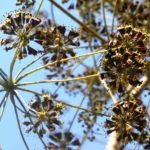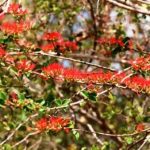TREE LIFE
OCTOBER 1993
MASHONALAND CALENDAR
Tuesday 5th October : Botanic Garden Walk. Park at the Herbarium where we will meet Tom Muller at 1645 hours for 1700 hours .
Sunday 17th October : Sadly Mauritian Thorn has almost engulfed the riverine vegetation at Lowdale, so the venue for this months‘ trip is changed.
We have visited Trance and Pat Bragge at Balkiza about 3 years ago, and there is still plenty of interest. Our program will differ a little from the norm because Trance has directed us to some magnificent rock art which features animals, humans, plants all amazingly clear and fresh looking.
Rob Burrett has kindly agreed to stimulate our imaginations by leading a discussion at the paintings which are not very difficult to reach, and well worth the effort. So the first part of the day will be spent up on the Kopje which has other surprises as well, such as Mimusops zeyheri and Syzygium cordatum growing along a dry gully. We will move on to the dam for our lunch and afternoon ramble. We meet at 0900 hours.
Friday 22nd October : The Trustees of the Bob Rutherford Memorial Trust announce the award of the Bob Rutherford memorial prize for 1993 to Dr. Peter Mundy, the well known ornithologist, ecologist and author of The Vultures of Africa. He will be presenting the Bob Rutherford Memorial lecture which will be titled “Large Birds, the Silent Barometer” at Meikles Hotel at 7 pm for 7.30 pm. Admission will be free and there will be a cash bar.
Saturday, October 23 : Marks’ Botanic Interest Walk. Borrowdale common, corner of Lanner and Teviotdale Roads, Meet at 1500 hours.
Tuesday 2nd November : Botanic Garden Walk
MATABELELAND CALENDAR
Sunday 3rd October : The usual rendezvous at Girls’ College for a double-bill. 0830 hours departure for a visit to Mr Mlapisane’s Natural Herb Garden and then onto Mabukuweni for the second event of the morning, a talk by June Davies on natural dyes. We have scheduled the latter event at 1000 hours for 1030 hours. With that in mind we will give ourselves a tea break from about 1000 hours. Please bring your own tea and chairs to Mabukuweni. Members should feel free to attend the two events as their own personal interests might lead them, thereby taking in one or both items of the days menu as they please. Do bring any interested friends.
Monday 11th October : Urban Trails, Hillside Dams at 1645 hours for 1700 hours.
Sunday 7th November and Sunday 5th December : Our two acacia schools at Glengary.
Monday 8th November : Urban Trails.
THE TREE SOCIETY OF ZIMBABWE MATABELELAND BRANCH : SUNDAY 5TH SEPTEMBER
Nineteen of us set off for the Matopos on a warm sunny morning to Rowallan Park where we had permission to leave our vehicles. (Our thanks to the Girl Guides). The Acacia goetzei within the grounds was quite bereft of leaves unfortunately.
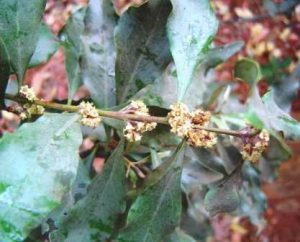
Euclea divinorum. Photo: Bart Wursten. Source: Flora of Zimbabwe
We set off through wooded grassland with pockets of Combretum apiculatum, C.hereoense, Euclea divinorum, E.racemosa, Acacia gerradii and A.rehmanniana all young specimens and taller more mature Kirkia acuminata, Sclerocarya birrea and Pterocarpus rotundifolius.
After crossing a dry reed bed we entered more mature woodland where our attention was drawn to a large Gardenia volkensii then an exquisite pink flowered Dombeya rotundifolia. Once through the gate into Gulati, we explored a densely wooded area which rewarded us with Berchemia zeyheri, Cordia grandicalyx, Mimusops zeyheri, Olea europea, Tarenna neurophylla, Vepris refleza and Ximenia caffra. A.strychnos madagascariensis on the edge of the path was initially identified as Combretum imberbe. A Lopholaena coriifolia swathed in a halo of silky white papus was a grand spectacle. Several leafless Commiphora schimperi took time to identify, after which we found a convenient shaded rocky outcrop for our tea break. Within the vicinity were Euphorbia griseola, E.espinosa, Elephantorrhiza goetzii and six or seven Aptosinum lineare peeping through dry tufts of grass.
On our return journey we followed the road/firebreak along the base of Imadzi to the main road, passing several white-flowering Dcmbeyas and one more pink, and a Combretum molle in full flower. The ‘morning only‘ members had by this time driven homewards leaving ten of us to picnic at the quarry picnic sites. The predominant species in the area was Pseudolachnostylis maprouneifolia. A lone baboon sat in the huge Parinari curatellifolia just beyond our clearing having his lunch. Further afield were fruiting Pittosporum viridiflorum, Tarenna neurohylia and T.zimbabwensis growing side by side and an escaped lemon tree.
In all a very pleasant day.
-Margaret Mccausland.
BOTANIC GARDEN WALK – 7 SEPTEMBER 1993
A request for flowering trees and continuing with Lowveld species were well catered for when Tom took us to see his superb Fernandoa magnifica covered with a dazzling array of red to yellow flowers. Although not a lowveld species there has been a recorded sighting in the Savannah woodland of the Sabi Valley.
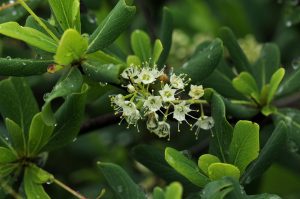
Teminalia stuhlmannii. Photo: Meg Coates Palgrave. Source: Flora of Zimbabwe
The lowveld tree species are often characterised by dwarf (or not so dwarf) lateral spines. This was evident in Teminalia stuhlmannii which displayed spines as well as the distinctive layering pattern of the branchlets. More spines were noticed on a Diospyros senensis, along with the tiny leaves “tucked in” on the branches. Ficus stulhmannzi was noted having large leathery leaves and short thick petioles. The fruit was a small sphere with a knobby end tinged with pink.
In the “Jesse” section, Entandrophragma caudatum (wooden banana) was examined, the common name being the best description of the splitting mature fruit. Exocaria bussei EUPHORBIACEAE had a single remaining brown 3 lobed split capsule which is typical of the species. The leaves although dry had a distinctive scalloped margin.
The BURSERACEAE family came next and Commiphora karibensis was leafless as expected but with dark grey bark and more stubby branchlets than the more common C.mollis. Tom mentioned that this species is generally restricted to ‘jesse‘ and is often elephant damaged. C.ugogensis (impressive name!) was totally different with a green under bark, brown peeling outer bark and spiny young branchlets.
Even though the name of Combretum elaeagnoides may stir the imagination the specific name refers to the small grey growing tip. The whorls of leaves that we have become accustomed to with Combretums were absent, instead the pattern being opposite to sub-opposite. A cluster of three winged fruits with a hint of a forth wing on each calyx puzzled us. Tom gave the name as another of the Combretum_family, Pteleopsis myrtifolia.
Near the end of the walk we found Friesodielsia obovata, its fruit being a cluster of red cylindrical pods which hang down when mature. With Schrebera trichoclada the common name of wooden peer is an apt description. Unfortunately no fruits could be seen. The last tree we looked at was Xeroderris stuhlmarnii, (the teutonic specific names rolling off Tom’s tongue with ease! 5, the green compound leaf being somewhat harsh to the touch. The texture of the leaf was similar to Loncocarpus cappasa, both trees being of the FABACEAE family. Xeroderris stuhlmannii also displays a red ooze if its bark if damaged or slashed.
Again very many thanks to Tom for a most interesting and entertaining walk.
-Andy Macnaughtan
ELMSWOOD FARM – MARONDERA
Almost 1 hundred years ago, it was August 1894, Alice Balfour painted beautiful Mount Zonga, showing clearly the colours of the spring Musasa foliage at the foot. Page 387 of her Journal reads “There were pretty hills in all directions, and great tracts wooded with Sagoussy trees, all shades of pink, crimson and orange”. (“Sagoussy” -‘the word was changed to “Magoussy and is probably an anglicised variant of the Kalanga “muguzhe”). The dotted foreground of that painting shows tufts of grass roots remaining after the grass has been burnt off. Last week Mrs Bell had telephoned to say that a fire had swept through the farm but the trees around the homestead were unharmed – we feared the worst! Need we have even given it a thought; undoubtedly this terrifying fire had swept along the valley up to the ostrich pens and through the gum plantation on the far side, but the pretty hills clad in spring colours are still there, ‘like the work of Titanic gardeners’ (Alice Balfour). So nothing has changed in a hundred years.
We could not have had a more interesting and absorbing day from the time that Chris welcomed us at the entrance of the garden encircled by granite boulders of all sizes and shapes and shaded by large indigenous trees. Tea was laid out on the green lawn and soon the crowd gathered to greet each other and to chat and admire the house and garden. It was pleasing to welcome local members from the district and further afield. John and Lilian Cotrill had come over from Bindura and a very welcome visitor from Wedza was Mrs Corona Thornycroft. For many years‘ Corona has been studying the prehistoric rock art of this country concentrating on the paintings in the Marondera and Wedza districts and has been tracing and interpreting these work for the benefit of archaeologists and so it is no surprise that one of the flowering sprays brought over by her for positive identificafion was that of Acokanthera oppositifolia the common poison bush which was used extensively in the preparation of arrow poison.
Perhaps the spring weather influenced us but treeing on this nice warm day was a light-hearted affair with lots of fun. Chris led us through a gate built into a wall joining two large granite boulders; a Ficus thonningii had draped itself gracefully across the top and was our first object of discussion. Through the gate into another world; this was to be the home of the African duck and as yet was incomplete but close to the wall there were several large ponds, which I suspect will soon house water-lilies! I had wondered why Chris said he was interested in meeting John Cottrill when he was introduced to him. The path lead to the bottom of the hill and along the foot where we found many large and lovely trees as well a varied selection of smaller ones and shrubs and spring flowers. A larger than usual Garcinia buchananii quite untouched by the medicine man was most impressive; the thick and sticky sap known as “yellow blood” must have some medicinal properties as it is popular with them – could it be Vitamin C? Further along stood a Ficus sur laden with bunches of fruit; we never tire of hearing the fig wasp story, and so opened one or two to see if the minute female wasp had wormed her way in to lay her eggs yet, but perhaps it was too early. A chance remark by Chris that he noticed that the different species of figs do not flower and fruit at the same time brought forth yet another interesting fact about figs – that each species have a different pollinating wasp and that they do not fruit at the same time in order to preserve the fruit wasps and thus their own survival.
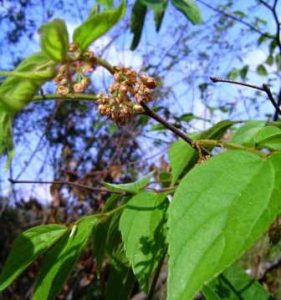
Celtis africana. Photo: Bart Wursten. Source: Flora of Zimbabwe
The nearest we got to Elmswood was the numerous Celtis africana the white “stinkwood” and sometimes called the African elm. There were just as many Erythrina latissima judging by the vivid splashes of red all over the hill; this we did expect to find as it is a species of the granite kopjes with larger leaves and larger seeds than our common E.abyssinica. Surely the highlight of the day was an Olinia vangueriodes (Rhodesian oliniai ) endemic to this country. It has pink petioles and red tinged leaves, but it is the dark grey bark and creamy under bark that make it so striking. Age does nothing for this tree – later we were to find a much younger one and the mottled bark of different shades of grey and cream-and yellow was a combination so beautiful that could only have been achieved by nature. It was good to find Dovyalis zeyheri (oval kei-apple) but to us the race track tree – so that we could search amongst the leaves to see once again the tiny little insect at work making white tracing in and out and round about the leaves. Mayenus undata were fairly numerous; years ago the Tree Society found a way to positively identify this tree by rubbing off the powdery bloom on the surface of the leaves producing a distinct musty smell infallible. We came upon a larger than usual Erythroxylum emarginatum, the ommon coca tree and generally a shrub; the stiffly textured leaves held to your ear and crushed in half make a sound like popping rice crispies.
Chris‘ “imports” all seemed to be growing well, especially the Turraea nilotica, known in South Africa as the bushveld honeysuckle tree. An apt description, for it was in full bloom, white and yellow petals curling back from a very long staminal tube up to 1.5 cm. long. Cheryl posed the question — what insect or bee pollinates it with such 3 long stamin to hinder the process. We came across a similar one in the last flowering of the winter cassia, now Senna singuena . It is Phil’s theory that beetles could be the pollinators – they are quite rough and simply bulldoze their way into the flowers to reach the nectar.
How very lucky we are in that we can share with our members their plans in creating the unusual and beautiful – do you remember our visit to Rob Pare’s little forest, specially grown to encourage and feed and house butterflies. And John and Lilian’s park-like tree garden. Chris had a surprise for us – we discovered the embryo of a miniature rain forest. It is an ideal situation a long almost straight line of Acacia sieberana grown at the foot of the hill, as though planted by man. The reason is quite simple – under the ground there is a water course and the trees know a good thing when they find it. So Chris is planting many and varied indigenous trees there, large and small to provide an under-storey and canopy. What a lovely idea and we wish him the best of luck. So for his imports are doing well, even to the essentially lowveld Tabernaemontana elegans, the toad tree.
Alice Balfour painted some beautiftul trees and another one I like very much is a lone Acacia tree (the archives call it a Camel Thorn but that I do doubt). High on the banks of the Tati River. I said nothing changes – I was referring to trees and not to humans. Her Journal entry at page 132 makes amusing reading —
“We outspanned at Tati this am., a dreary looking place, but with the redeeming feature of a river which actually had water in it. Its banks, too, were higher and more picturesque than usual. .. .. .. I sketched from the bank overlooking the river, much to George (Grey’s) disgust, I afterwards learned, as he was prevented from bathing by my command of the whole course of the stream.”
ELMSWOOD – AFTERNOON RAMBELINGS
After lunch under some large Acacia sieberiana with their resident masked weavers twittering in the warmth, Chris took us to see his duck collection.
Through a gap in the rocks adjoining the house we sauntered about admiring the collection and also the aviaries that had been constructed. A Ficus thonningii had invaded some time ago and cast some welcome shadows onto a corner of an enclosure where we heard more about indigenous and exotic duck species.
Larger and more profitable birds followed, this time watching several pairs of ostriches move about in their enclosures. After hearing that ostrich eggs require turning every four- hours day and slight, tobacco curing sounds easier. Also the ever present bacteria can ruin a collection of eggs in an incubator if not constantly monitored and the “bad eggs” discarded immediately. A large number of ostrich chicks in pens near the factory indicated that the work involved had its rewards.
The furniture warehouse was a treat with all sorts of superbly made furniture. Fancy a replica (with carved sections!) of a Victorian chair with hide bracing or a large desk with dark stain finish. It was a delight to slide drawers backwards and forwards within their well cut guides. Some very useful bookcases in a light coloured wood were noticed along with an unusual piece of furniture a music centre for tapes and associated electrical equipment, complete with glass fronted doors.
The factory was home from home with drill presses, belt sanders, players and routers in evidence and all in superb condition. A small sandblasting machine at the corner of the factory was used to dress and touch up the brass castings used for handles and hinges on the furniture. In keeping with present conservation themes all the timber used was seasoned pine or saligna.
Unfortunately all good things come to an end and it was time to head for home. However, an immaculate 1949 Landrover series I was close enough for a quick look 4x_4’s have come alongway since then.
Thank you Chris and Rozanne for your hospitality and for making it a most enjoyable day.
-Andy Macnaughtan
SEED : If any members are visiting the Zambezi Valley please remember Tom Muller of the Botanic Garden. Tom is very anxious to acquire seeds of the plants which make up the “Jesse”, especially the Combretums – C.elaeagnoides, C.celastroides, C.obovatum aid C.padcides. They can be posted to Tom at P 0 Box 8100 Causeway, delivered to the Herbarium – Downie Avenue, Alexander Park or left with Maureen Silva-Jones on the l0th Floor, Southampton House, Union Avenue.
Paper packets should be labelled with seed identification, locality and date ollected and Collectors name. .
The Committee of any club or society regularly needs new blood and new ideas in order to remain alive, vital and interesting. If you would like to contribute to the running of the Tree Society please approach any Committee Member or write to Box 2128. No special skills are necessary just a little of your time each month.
We’re also looking for a new secretary so that Maureen. can devote more time, to the mapping exercise.
OUTING TO ELMSWOOD AT MARONDERA – 19 SEPTEMBER 1993
In addition to being a farmer and furniture maker par excellence, Chris Bell is a most enthusiastic keeper of ducks. So, in the afternoon, after picnicking on the verdant lawn in front of his delightful house, he showed us around his collection of ducks.
Chris told us that 36 species occur in Africa and breed here.
Firstly, looking at Teal: we saw European Green-winged Teal and very rare, a pair of Marble Teal from Iran, so rare that they have become almost shot out and could appear on the Cites list of endangered species quite soon. There were Hottentot Teal with pale blue bills which contrasted strongly with the Cape Teal which has a pale pink bill. Chris said that Cape Teal are found here in Zimbabwe but mostly in places where alkaline conditions exist. He pointed out that the males are brighter than the females – quite a common feature in the bird world. It appears that Cape Teal used to be recorded in big numbers here at one time but have now become quite scarce.
Next were the Shelducks: there were beautiful Ruddy Shelduck from Russia which winters here in Africa and European Shelduck which have been bred here. South African Shelduck which is endemic to the Cape and an interesting feature of this bird is that the configuration of the white part on the face of every female is different .
Then came the quite striking Knobbilled duck which nest in holes in trees. It appears that Mrs Knob-billed duck does all the rearing and the male takes almost no part in this. And alongside, looking very handsome were Fulvous Whistling ducks, otherwise known as tree ducks. We were told that it and the Knobbilled are the only two ducks to nest in trees in this country.
We moved on to European Pochard; European Widgeon and a European Tufted duck sporting a very slick tuft which Chris says becomes quite conspicuous in the Breeding season. Gadwall, also from Europe (commonly known as Grey duck) usually take 2/3 years to adapt but can breed here. The main difficulties experienced are adjustments to the different day 1ength. The same is also true for the European Pintail where moulting is a problem for the same reason.
Two Shovellers were noted –the European which has a dark lead—coloured spatula bill with which it sifts through muddy water when foraging and the Cape Shoveller which sports a dark reddish-brown spatula bill.
And finally, from inside the house, looking out on a shining pool immediately below, the dining room window where a pair of beautiful African Pygmy geese (smallest geese in the world) and we got quick peeps at a Flufftail darting about in the reeds at the far side of the pond.
A fact I had not realised until Chris told us was that there is not one true goose, all are ducks.
Grateful thanks to Chris for sharing his water birds with us. It was a welcome, cooling experience after the heat of midday.
-Marjorie Barker.
MAKING THE DESERTS BLOOM – ISRAEL’S RECLAMATION OF THE NEGEV
By Henry A Rule
In the barren, undulating scrublands of the northern part of the Negev Desert an area of southern Israel that for centuries has supported little more than a primitive pastoral economy, the observant visitor is surprised to stumble across the enduring evidence of once rich and thriving communities foundations of important buildings, cisterns, wells and carved stone water channels.Why this treeless waste? These deeply gullied hillsides? This structureless soil? The reasons are the same almost wherever such scenes are repeated throughout the world. The trees were removed, the grazing animal introduced, the soils washed away and the land died.
Throughout Israel, a land once rich in forest, history has made relentless demands on her timber resources. Apart from the needs of cities, ports, ships, fuel, charcoal etc., the land has suffered countless wars, forest fires and the massive appetite of the early railways. On top of all this, an earlier ‘dependence’ on sheep and goats to support an ancient-nomadic way of life destroyed all hopes of natural regeneration.
Against the daunting background, Israel‘s Forest Department of Keren Keyehemet L’lsrael (The Jewish National Fund) has developed one of the most outstandingly successful dry land reafforestation programnes to be found anywhere in the world, and vast areas of once inhospitable, unproductive land is now under a rich canopy of forest providing a wide range of social and environmental benefits in the form of employment, industry, soil stability, moisture retention, shelter and recreation.
WHY AND HOW HAS THIS TRANSFORMATION BEEN ACHIEVED?
The almost empty regions of the Negev Desert cover well over fifty per cent of Israel’s land surface, whilst the rapidly increasing population is concentrated in the cities and already intensely cultivated rural areas of the northern and costal regions of the country. It has become therefore, a priority to reclaim this vast area of land to increase the nation’s agricultural base and ease the pressure on its conurbations.
In the northern Negev in the region of its “capital city” Beersheba about which this article is conserned, the soil is formed of weak, structureless, wind deposited loess, a product of weathered cretaceous limestone. Its colloidal nature prevents the permeation of rainwater which in any case, only amounts to 8 to 10 inches per annum and most of this is quickly lost through rapid run off which causes the characteristic destructive gullying that scars the landscape. It is here at Yattir Forest, that a remarkable transformation is taking place.
Work on reclamation begins during the summer months when the thorny scrub is burned off and the hillsides are prepared for tree planting by teams of workmen with mattocks who cut one metre long trenches, one and a half metres apart and about nine inches deep in staggered rows two metres apart along the contours of the hills. The excavated soil is drawn up in mounds on the lower side of each trench.
On shallower slopes this work is done by heavy disc plough: drawn along the side of the hills creating deep furrows. These trenches and horizontal furrows act as highly efficient rainwater catchments which reduce surface run off and force the water to permeate into the broken ground.
In February when the rains come and the soil moisture level has risen to “field capacity” an extra large field force is mobilised and the short, but intense period of tree planting begins. The tree seedlings, raised at government nurseries in central Israel, are brought in by lorry to the planting area and quantities are distributed to each tree planter in a container. Then, under the direction of a supervisor, teams of planters spread out over the hillsides to the appointed planting areas. In the meantime, other teams armed with pick axes, move ahead of the planters and with one blow, hack out a planting pit just below the summit of the mound of excavated soil beneath the trenches.
From then on the planters quickly insert one seedling from their container into the loosened soil and without firming down, the surround soil is drawn up loosely around the base of the plant and then left for the rains to settle the soil firmly but naturally over the root zone. In this way the planting teams are able to move very quickly, thereby reducing the stress on the transplant and achieving a high rate of planting within a very short planting season. At Yattir Forest, the teams with which the author was working, planted over a quarter of a million trees within a two week period.
The principal tree species used in the Yattir Forest project is the Aleppo pine Pinus halepemis . This is intermixed periodically with the Horsetail tree (Casuarina equisetifolia), the Italian Cypress (Cupressus sempervirens) also C.arizonica, Acacia spps {Acacia saligna ) and in selected areas the River Red (Eucalyptus camaldulensis).
As a result of the very high percentage of “take” it is usually unnecessary to carry Out any “beating up” in the year after planting. When one considers the seeming fragility or a one year old P.halepensis seedling, not more than 6″ high, the apparently canal method of planting and the severity or the local environment, this degree of success is astonishing. The whole secret lies in the advance preparation and the accuracy or the timing of the planting.
Within the shelter of the old areas of Yattir Forest, which was started in 1964, the gullies on the gentler slopes have been filled in, the land graded and brought under cultivation for the production of wheat, almond, pistachios etc., all contributing to the local econony in addition to the income generated by the sale of forest products and meeting the demands of the growing numbers seeking recreation in a forest environnenmt.
The story or Yattir and other similar dry land forests in Israel is one of enormous hope. It demonstrates that when man collaborates with nature, her powers of recovery are truly massive and that even the most terrible or the Earth’s wounds can be healed. In the case or Israel, Isaiah’s great prophecy is being fulfilled ‘When her people return, the deserts will bloom like the rose.”
Acknowledged with thanks to author and publisher or the Journal of the International
Trees Foundation Vol. 52 1992.
ANDY MACNAUGHTAN CHAIRMAN


